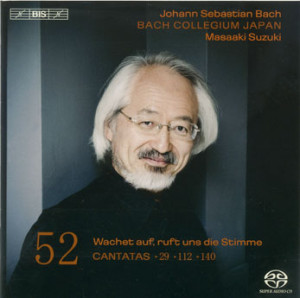Having very favorably reviewed several earlier installments of the Bach Collegium Japan’s now near-complete cycle of Bach cantatas, listening to this 52nd volume is a delight. Throughout this project’s 15-plus years, director Masaaki Suzuki has demonstrated an uncanny intuition and understanding of Bach’s genius, achieving a seamless interrelationship between instrumentalists and soloists that just seems so right, spot-on, perfect. The performances of these three mature Leipzig cantatas are likewise on the highest level, and regardless of how familiar you may be with the many other recordings of these works, any Bach or Baroque enthusiast would do well to add this outstanding BIS offering to their collection.
Wachet auf, Ruft uns die Stimme BWV 140 is Bach’s most famous and frequently recorded cantata. It’s an irrefutable masterpiece, and despite strong competition this performance clearly ranks among the best. Like Ristenpart (Accord) and Harnoncourt (Teldec, and recently Sony DHM), Suzuki’s rendering of the opening chorale is beautifully paced, allowing the ebb and flow of its fugal grandeur to effectively evolve. Suzuki’s handling of the wonderfully melodic inner choral/tenor movement, “Zion hört die Wächter singen”, is equally impressive in this regard; and with perhaps the exception of Peter Schreier in his prime for Richter (DG Archiv), Gerd Türk’s heartfelt delivery here is peerless. In the two soprano and bass duets, Suzuki’s tempos—slightly slower, if not broader than we usually hear—allow soloists Hana Blazikova and Peter Kooij expressive, emotional opportunities that they duly take advantage of.
Der Herr ist mein getreuer Hirt BWV 112 and Wir danken dir, Gott, wir danken dir BWV 29 receive exemplary performances as well. The opening chorale of BWV 112, where corno da caccia and chorus combine forces, is even more resplendent than in most renditions on disc. In the fourth-movement duet, “Du bereitest für mir einen Tisch”, soprano Blazikova (a voice new to me, and one that seems perfect for this repertoire) absolutely soars, even marginally bettering Sandrine Piau’s outstanding effort for Ton Koopman (Challenge Classics). Like the opening chorale of BWV 112, the rousing sinfonia that opens BWV 29 with prominent organ and brass makes a memorable impression. Countertenor Robin Blaze in his arioso “Halleluja, Stärk und Macht…” delivers a brief yet wonderful lyrical performance, again aided by Suzuki’s ideal tempos and phrasing.
The sound is spectacular. The balances between and among singers, choir, and orchestra are life-like and richly detailed, equal to the finest in this series. This is one of those rare programs that defines categories. If asked for a definitive Tosca for instance, the 1955 Callas performance comes instantly to mind. A recommendation for just one French Baroque program? Jordi Savall’s magnificent soundtrack to Tous les Matins du Monde. No LP or CD of Bach’s sacred cantatas has impressed me enough to distinguish it as such—until now. Highly recommended.
































